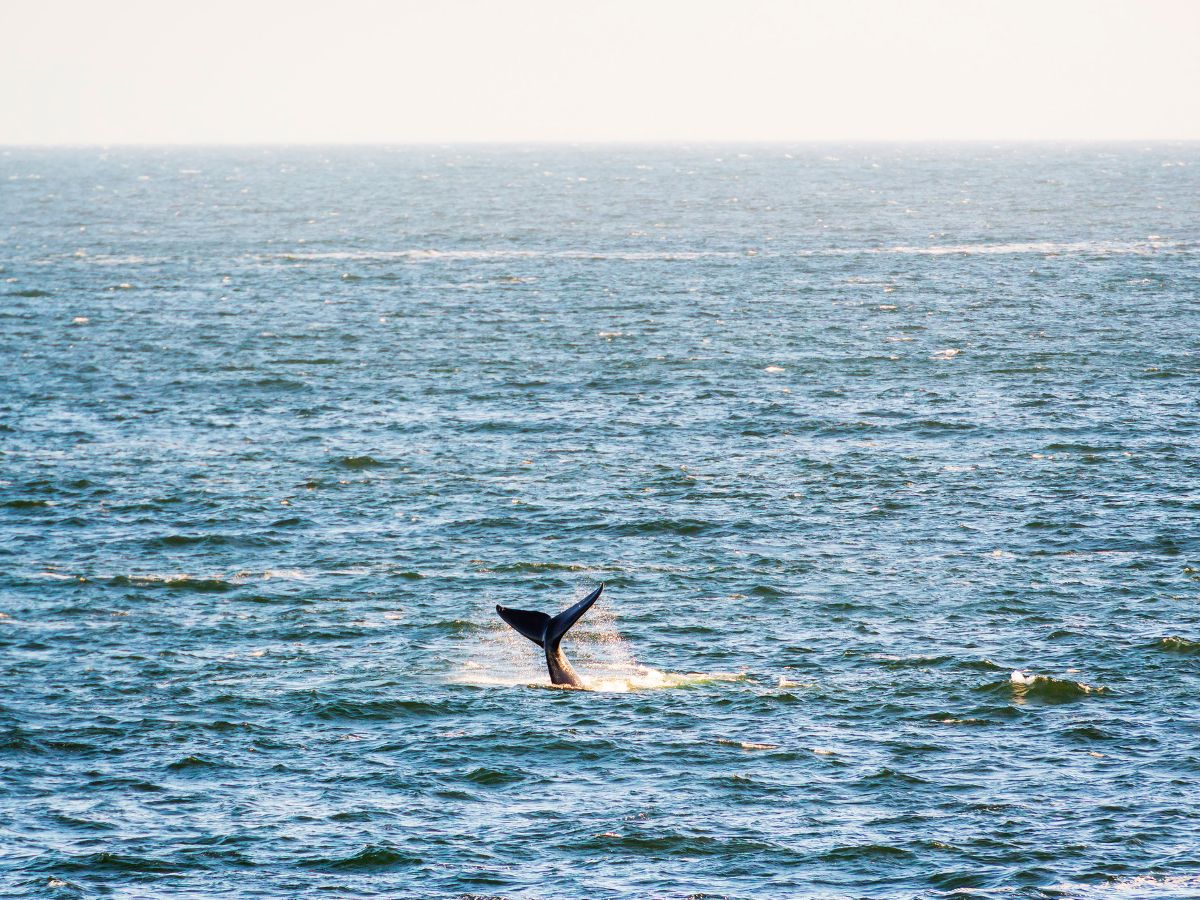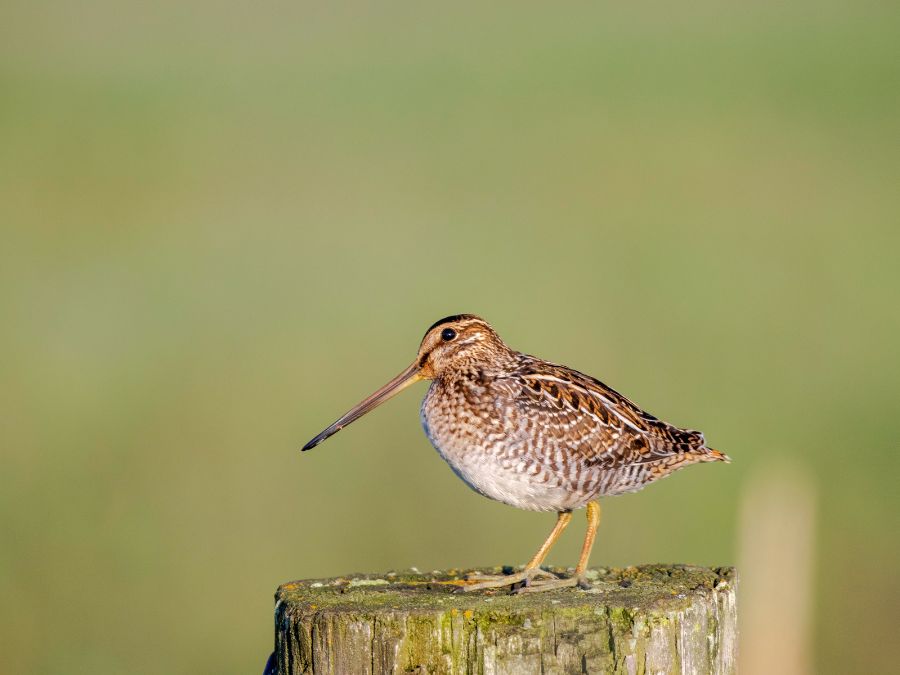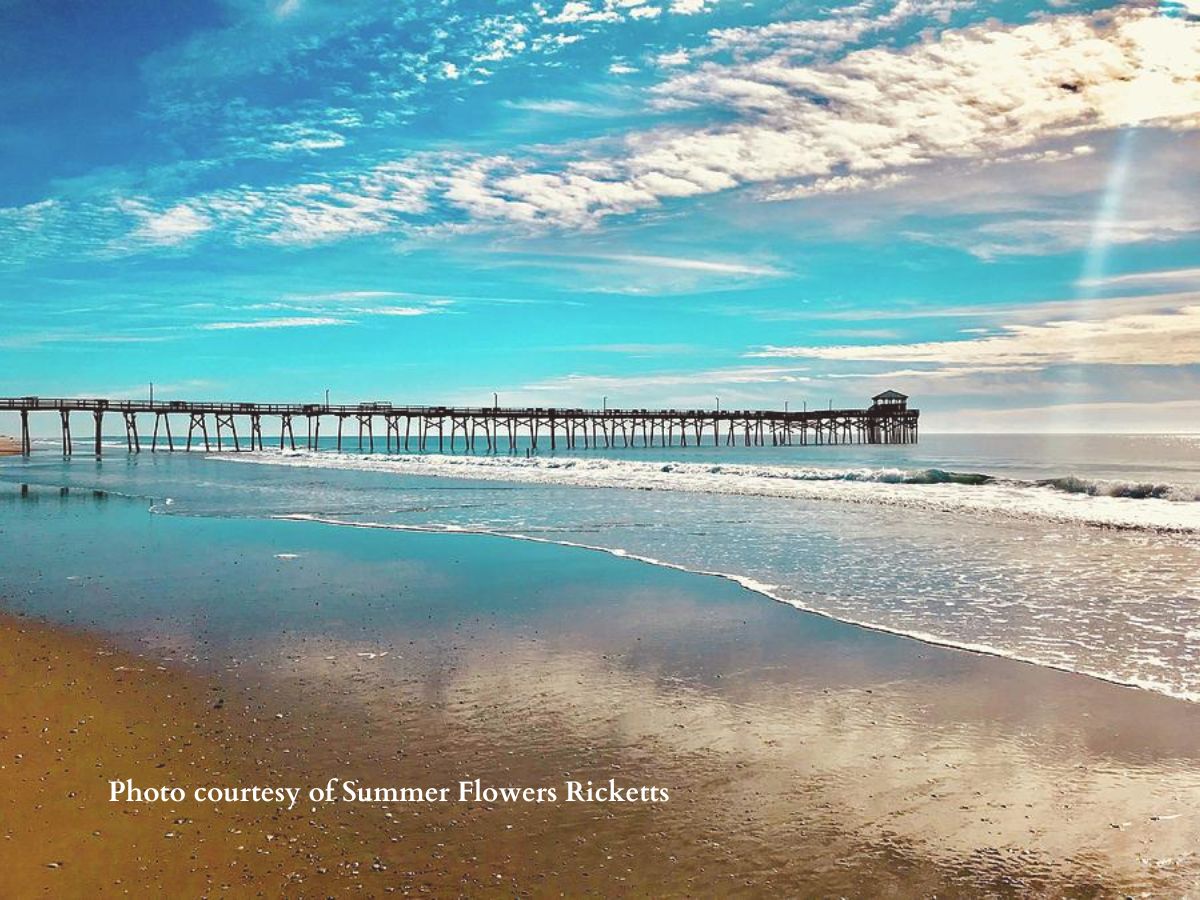Natural Carteret — 5 Min Read
Lookout for whales
By Jessi Waugh
Natural Carteret — 5 Min Read
Lookout for whales
By Jessi Waugh
If you live in Carteret County, you’ve almost certainly seen a whale.
Whales come in two varieties – those with teeth (Odontoceti) and those with baleen (Mysticeti). My bet is that you saw a toothed whale: a bottle-nosed dolphin. Dolphins are whales.
If you sit long enough on our beaches, you’ll see a pod of dolphins make their way along shore – catching fish, breaking the surface with their sleek rounded bodies, and, if you’re lucky, leaping in the waves. They’ve even been known to surf.
You might have heard them called porpoises, and there are occasionally porpoises in our waters, too, but they tend to range north of us. Chances are, the fin-topped flashes were dolphins.
And if you’re really lucky, you might spot one of the migratory whales that pass by our coast. Right whales, humpbacks, beaked whales – 34 species have visited NC. Right place, right time, and you could see the largest animals on Earth without ever taking an Alaskan cruise.
But let’s say you’re impatient and want to see a whale right now.
If you’ll settle for a skeleton, the Maritime Museum has that covered.
In the NC Maritime Museum in Beaufort (on Front Street), three full whale skeletons hang suspended from the ceiling – a 33ft sperm whale, a pygmy sperm whale (it’s a real thing), and a bottle-nosed dolphin. They even have the sperm whale’s heart, which has been plastinated (the flesh was turned directly into plastic). The author of this post has TOUCHED it.
The Maritime Museum is a great place to learn about whales and our history with them – scrimshaw carvings, whale hunting, oil lamps. Twice now, the author has SMELLED the museum’s spermaceti, the liquid from inside a sperm whale’s head. Unforgettable.
This month, the Maritime Museum will host the NC Whales and Whaling Symposium on Saturday, March 22nd, where specimens and experts will converge like a pod of dolphins, sharing their love of these endangered marine mammals with the public. Register online or by phone.
And that’s not all.

Opened in 2021, Bonehenge Whale Center in Beaufort (near the bridge) gives tours to visitors by appointment (12 years old+). They focus on marine mammal research, education, and conservation. They have all the skeletons and whale-talk you can handle.
But what if you finally do see a whale, and it’s not swimming in the ocean but stranded on shore, struggling – injured by a boat or marine debris?
Time to be a whale hero.
Call the Marine Mammal Stranding Network, and they will send a crew to save the animal if possible. If a heroic rescue is not possible, scientists like Vicky Thayer from CMAST perform a necropsy to find how the whale died and help save the next one.
In the words of Christine Brin, Associate Education Curator of the Maritime Museum, “The [Marine Mammal Stranding Network] takes advantage of even the worst situation to learn.”
I invite you to take advantage of the local wealth of whales and join the efforts to preserve these beasts of the deep for generations to come.
If you live in Carteret County, you’ve almost certainly seen a whale.
Whales come in two varieties – those with teeth (Odontoceti) and those with baleen (Mysticeti). My bet is that you saw a toothed whale: a bottle-nosed dolphin. Dolphins are whales.
If you sit long enough on our beaches, you’ll see a pod of dolphins make their way along shore – catching fish, breaking the surface with their sleek rounded bodies, and, if you’re lucky, leaping in the waves. They’ve even been known to surf.
You might have heard them called porpoises, and there are occasionally porpoises in our waters, too, but they tend to range north of us. Chances are, the fin-topped flashes were dolphins.
And if you’re really lucky, you might spot one of the migratory whales that pass by our coast. Right whales, humpbacks, beaked whales – 34 species have visited NC. Right place, right time, and you could see the largest animals on Earth without ever taking an Alaskan cruise.
But let’s say you’re impatient and want to see a whale right now.
If you’ll settle for a skeleton, the Maritime Museum has that covered.
In the NC Maritime Museum in Beaufort (on Front Street), three full whale skeletons hang suspended from the ceiling – a 33ft sperm whale, a pygmy sperm whale (it’s a real thing), and a bottle-nosed dolphin. They even have the sperm whale’s heart, which has been plastinated (the flesh was turned directly into plastic). The author of this post has TOUCHED it.
The Maritime Museum is a great place to learn about whales and our history with them – scrimshaw carvings, whale hunting, oil lamps. Twice now, the author has SMELLED the museum’s spermaceti, the liquid from inside a sperm whale’s head. Unforgettable.
This month, the Maritime Museum will host the NC Whales and Whaling Symposium on Saturday, March 22nd, where specimens and experts will converge like a pod of dolphins, sharing their love of these endangered marine mammals with the public. Register online or by phone.
And that’s not all.

Opened in 2021, Bonehenge Whale Center in Beaufort (near the bridge) gives tours to visitors by appointment (12 years old+). They focus on marine mammal research, education, and conservation. They have all the skeletons and whale-talk you can handle.
But what if you finally do see a whale, and it’s not swimming in the ocean but stranded on shore, struggling – injured by a boat or marine debris?
Time to be a whale hero.
Call the Marine Mammal Stranding Network, and they will send a crew to save the animal if possible. If a heroic rescue is not possible, scientists like Vicky Thayer from CMAST perform a necropsy to find how the whale died and help save the next one.
In the words of Christine Brin, Associate Education Curator of the Maritime Museum, “The [Marine Mammal Stranding Network] takes advantage of even the worst situation to learn.”
I invite you to take advantage of the local wealth of whales and join the efforts to preserve these beasts of the deep for generations to come.
If you’re all caught up with EPIC Carteret, check out the NC Maritime Museum’s Salty Tales podcast. The museum’s energetic Associate Education Curator Christine Brin talks with historians, storytellers, and regional experts about local legends, marine life and more.
If you’re all caught up with EPIC Carteret, check out the NC Maritime Museum’s Salty Tales podcast. The museum’s energetic Associate Education Curator Christine Brin talks with historians, storytellers, and regional experts about local legends, marine life and more.





I did not know a Dolphin is a whale. Thanks, Teach! Good info here.
Thanks, Rose